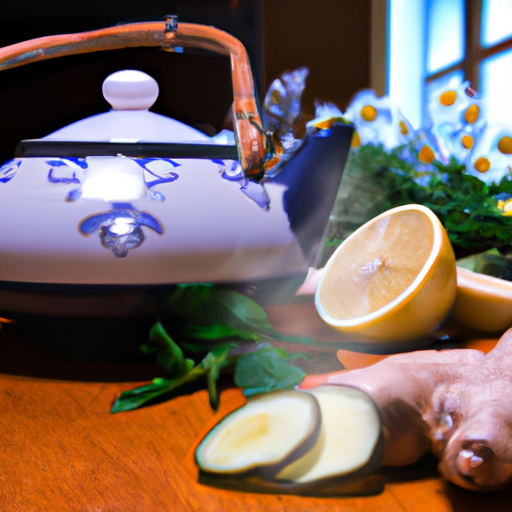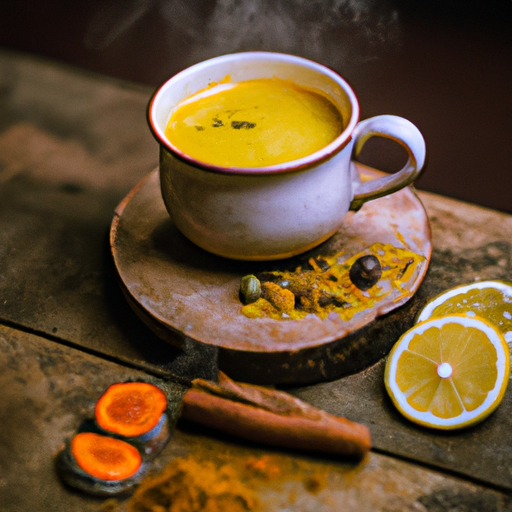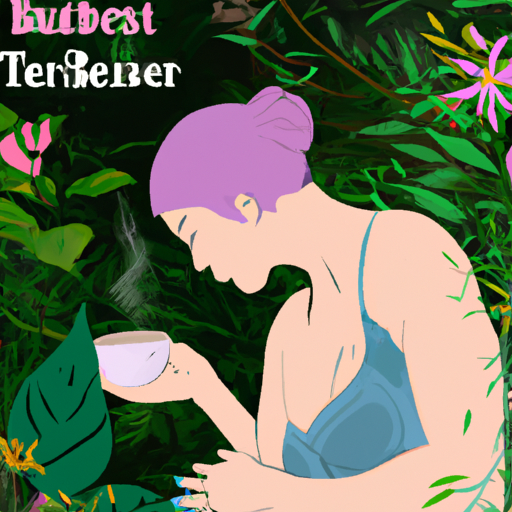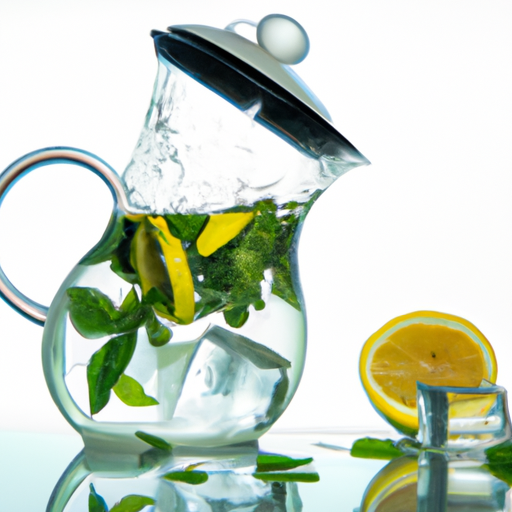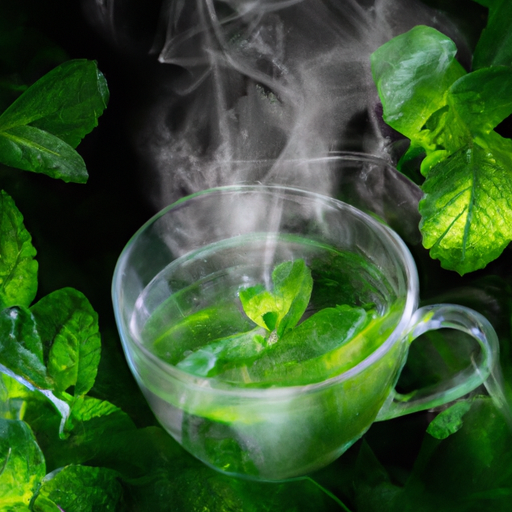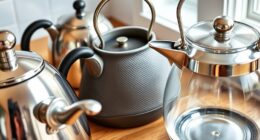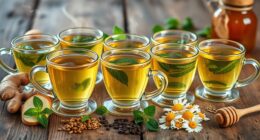Picture this: you wake up one morning feeling the telltale signs of a cold coming on. The scratchy throat, the stuffy nose, the overall feeling of fatigue. As the day progresses, you find yourself longing for a comforting remedy to soothe your symptoms and boost your immune system.
Look no further than the ancient art of brewing herbal tea. In this article, I will guide you through the process of making herbal tea specifically designed to alleviate cold symptoms. By harnessing the power of nature’s herbs and spices, you can create a warm and healing elixir that not only tastes delicious but also provides evidence-based benefits for your body.
So, join me on this holistic journey as we explore the right herbs to choose, the tools you’ll need, and the steps to prepare your own homemade herbal tea for cold relief.
Get ready to sip your way to wellness!
Key Takeaways
- Herbal tea made with Echinacea, ginger, peppermint, and chamomile can alleviate cold symptoms and boost the immune system.
- Lavender and lemon balm can be added to herbal tea for their calming properties.
- The infusion method is used to make herbal tea, using a teapot or heat-resistant glass jar with a strainer.
- Customizing the flavor of herbal tea with lemon, honey, stevia, ginger, cinnamon, or mint can enhance its taste and aroma.
Choose the Right Herbs and Spices
Now, let’s dive into the world of herbal teas and discover the perfect blend of herbs and spices that’ll soothe your cold-ridden body and warm your soul.
When choosing herbal tea for different health conditions, it’s important to consider the specific herbs and spices that’ll provide the desired benefits. For a cold, there are several options that can help alleviate symptoms and boost your immune system. Echinacea is a popular herb known for its immune-boosting properties, while ginger can provide relief for sore throats and congestion. Peppermint and chamomile teas are great choices for relaxation, as they have calming effects on both the mind and body.
Exploring the benefits of herbal tea for relaxation, it’s important to note that certain herbs and spices can have a soothing effect on the nervous system, promoting relaxation and reducing stress levels. Lavender and lemon balm are two herbs that are commonly used for their calming properties. These herbs can help to alleviate anxiety and promote a sense of calmness. Incorporating these herbs into your herbal tea blend can create a soothing and relaxing experience.
Now that we’ve explored the different herbs and spices that can benefit your cold and promote relaxation, it’s time to gather your ingredients and tools for the perfect cup of herbal tea.
Gather Your Ingredients and Tools
First, gather all the necessary ingredients and tools to create a comforting and soothing brew that’ll help alleviate your discomfort. Choosing the right brewing method is crucial to ensure you extract the maximum benefits from your chosen herbs.
For a cold, I recommend using the infusion method, as it allows the herbs to steep gently and release their healing properties.
To start, you’ll need a teapot or a heat-resistant glass jar with a strainer. This’ll help separate the herbal infusion from the herbs themselves. You’ll also need fresh, filtered water, preferably not boiling hot, as extreme temperatures can destroy some of the delicate compounds in the herbs.
As for the herbs, there are several options that can help relieve cold symptoms. Peppermint is great for soothing congestion, while ginger can help relieve a sore throat and reduce inflammation. Echinacea is known for its immune-boosting properties, and chamomile can provide relaxation and relieve cold-induced insomnia.
Understanding the benefits of different herbs is essential in creating an effective herbal tea for your cold.
Once you’ve gathered your ingredients and tools, you’re ready to move on to the next step: preparing your herbal tea.
Prepare Your Herbal Tea
To prepare your herbal tea, start by measuring out the desired amount of herbs and spices. I usually use about one tablespoon of dried herbs for every cup of water. Place the herbs in a tea infuser or strainer to make it easier to strain them out later.
Then, pour boiling water over the herbs and let them steep for a few minutes. This allows the flavors and beneficial compounds to be extracted from the herbs.
Enjoy the soothing and healing properties of your homemade herbal tea.
Measure out the desired amount of herbs and spices
Once you’ve gathered all your favorite herbs and spices, it’s time to measure out the perfect amount to create a soothing cup of herbal tea for your cold.
Different herbal tea blends offer various health benefits, so it’s essential to measure them accurately. Start by selecting the herbs and spices you want to include in your tea blend. Use a kitchen scale or measuring spoons to measure out the desired amount of each ingredient.
Remember, a little goes a long way, so be mindful not to overdo it. Once you’ve measured the herbs and spices, you can place them in a tea infuser or strainer. This will allow the flavors and healing properties of the herbs to infuse into your tea seamlessly.
Place them in a tea infuser or strainer
After carefully measuring out the desired amount of herbs and spices, it’s time to infuse them into your tea by placing them in a tea infuser or strainer. Using a tea infuser has numerous benefits. Firstly, it allows the herbs and spices to steep evenly, ensuring a well-balanced flavor. Secondly, it prevents any loose bits from floating in your tea, giving you a smooth and enjoyable drinking experience.
There are different types of strainers available as well, such as mesh ball infusers, silicone infusers, and disposable tea bags. Choose the one that suits your preferences and needs.
Once you have placed the herbs and spices in the infuser or strainer, it’s time to pour boiling water over them and let them steep for a few minutes. This will allow the flavors and medicinal properties of the herbs to fully infuse into your tea.
Pour boiling water over the herbs and let steep for a few minutes
As the boiling water cascades over the herbs, their flavors and medicinal properties begin to infuse into the tea, creating a fragrant and soothing brew. Herbal tea has been used for centuries as a natural remedy for cold relief, offering a range of health benefits. Different types of herbs can be used in herbal tea to target specific symptoms of a cold. For example, chamomile can help with congestion and sore throat, while peppermint can provide relief for nasal congestion and headaches. Echinacea and elderberry are known for their immune-boosting properties. Incorporating a variety of herbs in your herbal tea can provide a holistic approach to cold relief. Now, let’s move on to the next step and discover how adding honey or lemon can bring additional benefits to your herbal tea.
Add Honey or Lemon for Extra Benefits
To enhance the flavor and provide added benefits, don’t forget to mix in some honey or squeeze a fresh lemon into your herbal tea for a soothing and invigorating experience. Honey has been used for centuries as a natural sweetener and it also offers numerous health benefits. Not only does honey add a touch of sweetness to your tea, but it also has antibacterial and antiviral properties that can help relieve cold symptoms.
Additionally, honey can soothe a sore throat and ease coughing, making it a great addition to your herbal tea when you’re feeling under the weather.
Similarly, adding a squeeze of fresh lemon to your herbal tea can provide extra benefits. Lemons are packed with vitamin C, which can help boost your immune system and fight off cold-causing germs. They also have antioxidant properties that can reduce inflammation and support overall wellness.
Moreover, the tangy flavor of lemon adds a refreshing twist to your tea, making it even more enjoyable to sip on.
As your tea steeps and the flavors meld together, the honey and lemon will infuse the brew with their goodness. This combination of natural ingredients creates a delicious and health-promoting drink that will help to soothe your cold symptoms.
So, as your herbal tea cools and you strain it, get ready to experience the ultimate comfort and relief.
Let the Tea Cool and Strain
To fully enjoy the herbal tea and maximize its benefits, it’s important to allow it to cool to a comfortable drinking temperature. This will not only prevent burning your tongue, but it’ll also allow you to fully savor the flavors and aromas of the herbs.
Once the tea has cooled, remove the tea infuser or strainer and discard the herbs. This step ensures that you have a smooth and clear tea without any leftover bits of herbs.
Allow the tea to cool to a comfortable drinking temperature
Once the herbal tea’s at a pleasant temperature, it’s safe to enjoy its soothing effects on a sore throat. Proper cooling techniques are essential to ensure the tea’s at a comfortable drinking temperature. Here are four reasons why temperature’s crucial in enhancing the flavor and benefits of herbal tea:
-
Retains the potency of herbal compounds: Cooling the tea slowly helps preserve the delicate compounds in the herbs, ensuring maximum therapeutic benefits.
-
Improves taste and aroma: Allowing the tea to cool gradually brings out the subtle flavors and aromas, enhancing the overall taste experience.
-
Prevents scalding: Cooling the tea avoids the risk of burning your tongue or throat, allowing you to savor the tea without any discomfort.
-
Allows for customization: By adjusting the cooling time, you can tailor the tea’s temperature to your preference, whether you prefer it warm or completely cooled.
Once the tea’s cooled, it’s time to remove the tea infuser or strainer and discard the herbs.
Remove the tea infuser or strainer and discard the herbs
After the tea has reached a comfortable temperature, you can simply remove the tea infuser or strainer and discard the herbs. This step is important because it allows you to fully appreciate the soothing effects of the herbal tea on your sore throat.
But don’t just throw away those discarded herbs! There are different ways you can make the most out of them. One option is to save them and reuse them later for another batch of tea. You can also use them to make a relaxing herbal bath by tying them up in a cloth bag and adding it to your bathwater.
As for the tea infuser or strainer, if you don’t have one, you can use a fine-mesh sieve or even a coffee filter as alternative options.
With the herbs removed and the tea ready, it’s time to transition into the subsequent section about enjoying your homemade herbal tea.
Enjoy Your Homemade Herbal Tea
Now that you’ve made your herbal tea for a cold, it’s time to sit back, relax, and enjoy your homemade brew. Drinking herbal tea isn’t just soothing for a sore throat and stuffy nose, but it also offers a range of benefits for your overall health.
To make your herbal tea experience even more enjoyable, here are some different ways to customize your flavors:
- Add a squeeze of fresh lemon for a citrusy twist.
- Sweeten your tea with a teaspoon of honey or a sprinkle of stevia for a touch of natural sweetness.
- Experiment with different herbs and spices like ginger, cinnamon, or mint to create unique flavor combinations.
Drinking herbal tea has numerous benefits for your overall health. It can boost your immune system, relieve stress, aid digestion, and even promote better sleep. With each sip, you’re nourishing your body with the goodness of herbs and their healing properties.
Now that you know how to enjoy your herbal tea, don’t forget to store any extra tea for later use. This way, you can continue to reap the benefits of this comforting beverage whenever you need it.
Store any Extra Tea for Later Use
To keep the goodness of your homemade brew readily available, don’t forget to stash away any extra tea for future use. Storing your homemade herbal tea properly is essential to preserve its freshness and ensure that it retains its medicinal properties.
Here are a few tips to help you store your tea effectively.
First and foremost, make sure to store your herbal tea in an airtight container. This will prevent moisture and air from seeping in and affecting the quality of the tea. Glass jars with tight-fitting lids are ideal for this purpose.
Next, find a cool, dark place to store your tea. Exposure to light and heat can degrade the tea’s potency and flavor. Avoid placing the container near the stove or in direct sunlight.
Additionally, it’s important to label your tea with the date of preparation. This will help you keep track of its freshness and ensure that you use the oldest tea first.
Lastly, try to consume your stored herbal tea within six months. While it may still be safe to consume after this time, the freshness and potency may diminish.
By following these simple storage guidelines, you can enjoy the benefits of your homemade herbal tea for an extended period.
Frequently Asked Questions
Can I use any type of tea leaves or do I have to use specific herbs and spices?
You don’t have to stick to specific herbs and spices for herbal tea. There are alternative tea options like green tea or chamomile that offer their own health benefits. Experiment and find what works for you.
How long does it take for the herbal tea to cool down before it is ready to be consumed?
Herbal tea needs to steep for about 5-10 minutes before it is ready to be consumed. It is safe to drink herbal tea while it is still warm, but be careful not to burn yourself.
Can I use artificial sweeteners instead of honey to add sweetness to my herbal tea?
Yes, you can use artificial sweeteners instead of honey to add sweetness to herbal tea. However, it’s important to note that honey offers potential health benefits like antioxidants and soothing properties for a cold.
How long can I store the extra herbal tea for later use?
How long can herbal tea be stored before it goes bad? Can I freeze the extra tea for later use? It is recommended to store herbal tea for up to 2 years in a cool, dark place. Freezing is not necessary.
Are there any specific tools or equipment that I need in order to prepare herbal tea for a cold?
To prepare herbal tea for a cold, you don’t need any specific tools or equipment. The benefits of using fresh herbs include enhanced flavor and increased medicinal properties. There are different methods of brewing herbal tea for cold relief, such as steeping or simmering the herbs.
Conclusion
In conclusion, making herbal tea for colds is a simple and effective way to soothe symptoms and boost your immune system. By choosing the right herbs and spices, gathering the necessary ingredients and tools, and preparing the tea with care, you can create a comforting and healing beverage.
Adding honey or lemon can provide additional benefits, and allowing the tea to cool and strain ensures a smooth and enjoyable experience. Did you know that a study found that drinking herbal tea can reduce the duration and severity of cold symptoms by up to 50%? So why not give it a try and enjoy the natural healing power of herbal tea.

